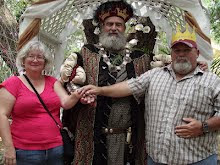Pumpkin History
References to pumpkins date back many centuries. The name pumpkin originated from the Greek word for "large melon" which is "pepon." "Pepon" was nasalized by the French into "pompon." The English changed "pompon" to "Pumpion." Shakespeare referred to the "pumpion" in his Merry Wives of Windsor. American colonists changed "pumpion" into "pumpkin." The "pumpkin" is referred to in The Legend of Sleepy Hollow, Peter, Peter, Pumpkin Eater and Cinderella.
Native Americans dried strips of pumpkin and wove them into mats. They also roasted long strips of pumpkin on the open fire and ate them. The origin of pumpkin pie occurred when the colonists sliced off the pumpkin top, removed the seeds, and filled the insides with milk, spices and honey. The pumpkin was then baked in hot ashes.
History of the Jack-o-Lantern
People have been making jack-o-lanterns at Halloween for centuries. The practice originated from an Irish myth about a man nicknamed "Stingy Jack." According to the story, Stingy Jack invited the Devil to have a drink with him. True to his name, Stingy Jack didn't want to pay for his drink, so he convinced the Devil to turn himself into a coin that Jack could use to buy their drinks. Once the Devil did so, Jack decided to keep the money and put it into his pocket next to a silver cross, which prevented the Devil from changing back into his original form. Jack eventually freed the Devil, under the condition that he would not bother Jack for one year and that, should Jack die, he would not claim his soul. The next year, Jack again tricked the Devil into climbing into a tree to pick a piece of fruit. While he was up in the tree, Jack carved a sign of the cross into the tree's bark so that the Devil could not come down until the Devil promised Jack not to bother him for ten more years.
Soon after, Jack died. As the legend goes, God would not allow such an unsavory figure into heaven. The Devil, upset by the trick Jack had played on him and keeping his word not to claim his soul, would not allow Jack into hell. He sent Jack off into the dark night with only a burning coal to light his way. Jack put the coal into a carved out turnip and has been roaming the Earth with it ever since. The Irish began to refer to this ghostly figure as "Jack of the Lantern," and then, simply "Jack O'Lantern."
In Ireland and Scotland, people began to make their own versions of Jack's lanterns by carving scary faces into turnips or potatoes and placing them into windows or near doors to frighten away Stingy Jack and other wandering evil spirits. In England, large beets are used. Immigrants from these countries brought the jack o'lantern tradition with them when they came to the United States. They soon found that pumpkins, a fruit native to America, make perfect jack o'lanterns.
Source: The History Channel
Pumpkin Facts
- Total U.S. pumpkin production in 2008 in major pumpkin producing states was valued at $141 million.
- Total production of pumpkins by major pumpkin-producing states in 2008: 1.1 billion pounds
- 496 million pounds of pumpkins were produced in Illinois in 2008.
- The top pumpkin production states are Illinois, Ohio, Pennsylvania and California.
- The top ten pumpkin producing counties in Illinois are Tazewell, Kankakee, Mason, Logan, Will, Marshall, Kane, Pike, Carroll and Woodford.
- Pumpkins are grown primarily for processing with a small percentage grown for ornamental sales through you-pick farms, farmers' market and retail sales.
- Around 90 to 95% of the processed pumpkins in the United States are grown in Illinois.
- Pumpkin seeds can be roasted as a snack.
- Pumpkins contain potassium and Vitamin A.
- Pumpkins are used for feed for animals.
- Pumpkin flowers are edible.
- Pumpkins are used to make soups, pies and breads.
- The largest pumpkin pie ever made was over five feet in diameter and weighed over 350 pounds. It used 80 pounds of cooked pumpkin, 36 pounds of sugar, 12 dozen eggs and took six hours to bake.
- Pumpkins are members of the vine crops family called cucurbits.
- Pumpkins originated in Central America.
- In early colonial times, pumpkins were used as an ingredient for the crust of pies, not the filling.
- Pumpkins were once recommended for removing freckles and curing snake bites.
- Pumpkins range in size from less than a pound to over 1,000 pounds.
- The largest pumpkin ever grown weighed 1,140 pounds.
- The name pumpkin originated from "pepon" – the Greek word for "large melon."
- The Connecticut field variety is the traditional American pumpkin.
- Pumpkins are 90 percent water.
- Pumpkins are fruit.
- Eighty percent of the pumpkin supply in the United States is available in October.
- In colonial times, Native Americans roasted long strips of pumpkin in an open fire.
- Colonists sliced off pumpkin tops; removed seeds and filled the insides with milk, spices and honey. This was baked in hot ashes and is the origin of pumpkin pie.
- Native Americans flattened strips of pumpkins, dried them and made mats.
- Native Americans called pumpkins "isqoutm squash."
- Native Americans used pumpkin seeds for food and medicine.
























No comments:
Post a Comment